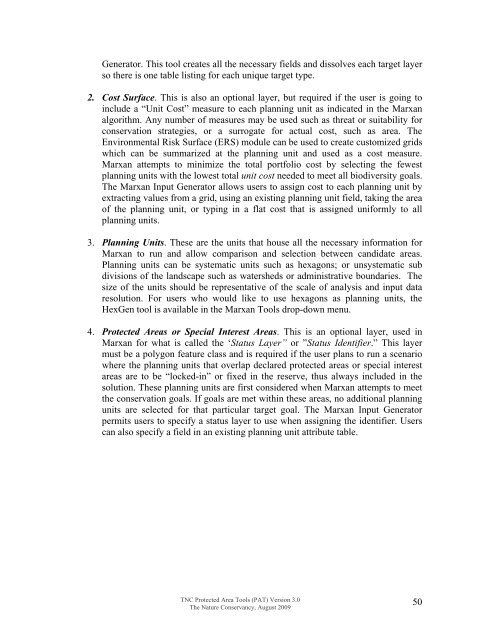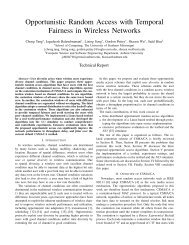Download the Tutorial
Download the Tutorial
Download the Tutorial
Create successful ePaper yourself
Turn your PDF publications into a flip-book with our unique Google optimized e-Paper software.
Generator. This tool creates all <strong>the</strong> necessary fields and dissolves each target layerso <strong>the</strong>re is one table listing for each unique target type.2. Cost Surface. This is also an optional layer, but required if <strong>the</strong> user is going toinclude a “Unit Cost” measure to each planning unit as indicated in <strong>the</strong> Marxanalgorithm. Any number of measures may be used such as threat or suitability forconservation strategies, or a surrogate for actual cost, such as area. TheEnvironmental Risk Surface (ERS) module can be used to create customized gridswhich can be summarized at <strong>the</strong> planning unit and used as a cost measure.Marxan attempts to minimize <strong>the</strong> total portfolio cost by selecting <strong>the</strong> fewestplanning units with <strong>the</strong> lowest total unit cost needed to meet all biodiversity goals.The Marxan Input Generator allows users to assign cost to each planning unit byextracting values from a grid, using an existing planning unit field, taking <strong>the</strong> areaof <strong>the</strong> planning unit, or typing in a flat cost that is assigned uniformly to allplanning units.3.4.Planning Units. These are <strong>the</strong> units that house all <strong>the</strong> necessary information forMarxan to run and allow comparison and selection between candidate areas.Planning units can be systematic units such as hexagons; or unsystematic subdivisions of <strong>the</strong> landscape such as watersheds or administrative boundaries. Thesize of <strong>the</strong> units should be representative of <strong>the</strong> scale of analysis and input dataresolution. For users who would like to use hexagons as planning units, <strong>the</strong>HexGen tool is available in <strong>the</strong> Marxan Tools drop-down menu.Protected Areas or Special Interest Areas. This is an optional layer, used inMarxan for what is called <strong>the</strong> ‘Status Layer” or ”Status Identifier.” This layermust be a polygon feature class and is required if <strong>the</strong> user plans to run a scenariowhere <strong>the</strong> planning units that overlap declared protected areas or special interestareas are to be “locked-in” or fixed in <strong>the</strong> reserve, thus always included in <strong>the</strong>solution. These planning units are first considered when Marxan attempts to meet<strong>the</strong> conservation goals. If goals are met within <strong>the</strong>se areas, no additional planningunits are selected for that particular target goal. The Marxan Input Generatorpermits users to specify a status layer to use when assigning <strong>the</strong> identifier. Userscan also specify a field in an existing planning unit attribute table.TNC Protected Area Tools (PAT) Version 3.0The Nature Conservancy, August 200950
















